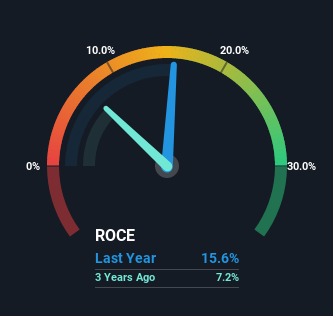- India
- /
- Metals and Mining
- /
- NSEI:SAIL
We Like These Underlying Return On Capital Trends At Steel Authority of India (NSE:SAIL)

If we want to find a potential multi-bagger, often there are underlying trends that can provide clues. Firstly, we'll want to see a proven return on capital employed (ROCE) that is increasing, and secondly, an expanding base of capital employed. If you see this, it typically means it's a company with a great business model and plenty of profitable reinvestment opportunities. So on that note, Steel Authority of India (NSE:SAIL) looks quite promising in regards to its trends of return on capital.
Understanding Return On Capital Employed (ROCE)
For those who don't know, ROCE is a measure of a company's yearly pre-tax profit (its return), relative to the capital employed in the business. Analysts use this formula to calculate it for Steel Authority of India:
Return on Capital Employed = Earnings Before Interest and Tax (EBIT) ÷ (Total Assets - Current Liabilities)
0.16 = ₹126b ÷ (₹1.2t - ₹393b) (Based on the trailing twelve months to June 2022).
Therefore, Steel Authority of India has an ROCE of 16%. In absolute terms, that's a pretty normal return, and it's somewhat close to the Metals and Mining industry average of 17%.
Our analysis indicates that SAIL is potentially undervalued!

Above you can see how the current ROCE for Steel Authority of India compares to its prior returns on capital, but there's only so much you can tell from the past. If you'd like to see what analysts are forecasting going forward, you should check out our free report for Steel Authority of India.
So How Is Steel Authority of India's ROCE Trending?
We're delighted to see that Steel Authority of India is reaping rewards from its investments and is now generating some pre-tax profits. About five years ago the company was generating losses but things have turned around because it's now earning 16% on its capital. And unsurprisingly, like most companies trying to break into the black, Steel Authority of India is utilizing 32% more capital than it was five years ago. This can indicate that there's plenty of opportunities to invest capital internally and at ever higher rates, both common traits of a multi-bagger.
One more thing to note, Steel Authority of India has decreased current liabilities to 33% of total assets over this period, which effectively reduces the amount of funding from suppliers or short-term creditors. So this improvement in ROCE has come from the business' underlying economics, which is great to see.
The Key Takeaway
To the delight of most shareholders, Steel Authority of India has now broken into profitability. Since the stock has only returned 30% to shareholders over the last five years, the promising fundamentals may not be recognized yet by investors. So exploring more about this stock could uncover a good opportunity, if the valuation and other metrics stack up.
Like most companies, Steel Authority of India does come with some risks, and we've found 1 warning sign that you should be aware of.
While Steel Authority of India may not currently earn the highest returns, we've compiled a list of companies that currently earn more than 25% return on equity. Check out this free list here.
New: Manage All Your Stock Portfolios in One Place
We've created the ultimate portfolio companion for stock investors, and it's free.
• Connect an unlimited number of Portfolios and see your total in one currency
• Be alerted to new Warning Signs or Risks via email or mobile
• Track the Fair Value of your stocks
Have feedback on this article? Concerned about the content? Get in touch with us directly. Alternatively, email editorial-team (at) simplywallst.com.
This article by Simply Wall St is general in nature. We provide commentary based on historical data and analyst forecasts only using an unbiased methodology and our articles are not intended to be financial advice. It does not constitute a recommendation to buy or sell any stock, and does not take account of your objectives, or your financial situation. We aim to bring you long-term focused analysis driven by fundamental data. Note that our analysis may not factor in the latest price-sensitive company announcements or qualitative material. Simply Wall St has no position in any stocks mentioned.
About NSEI:SAIL
Steel Authority of India
A steel-making company, manufactures and sells iron and steel products in India and internationally.
Proven track record and fair value.


